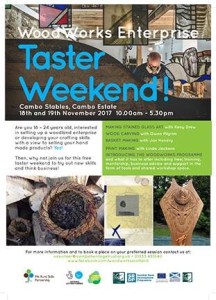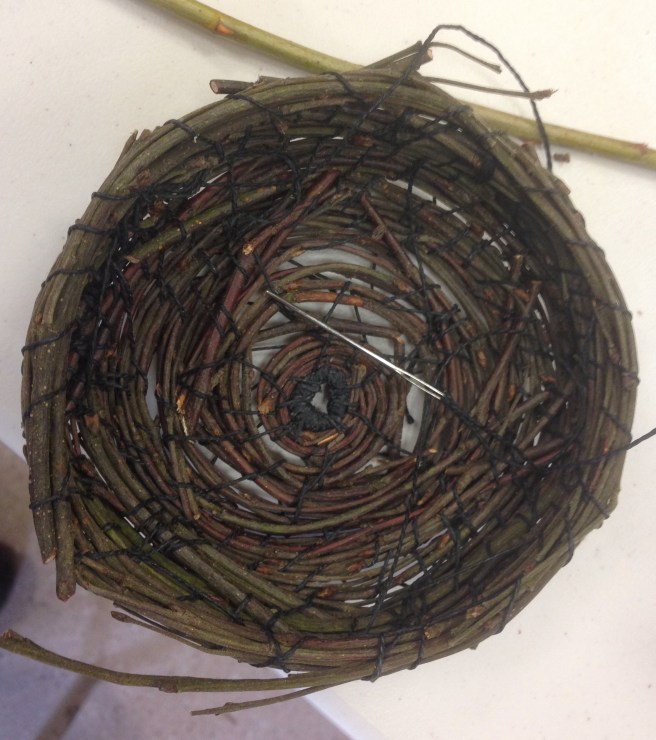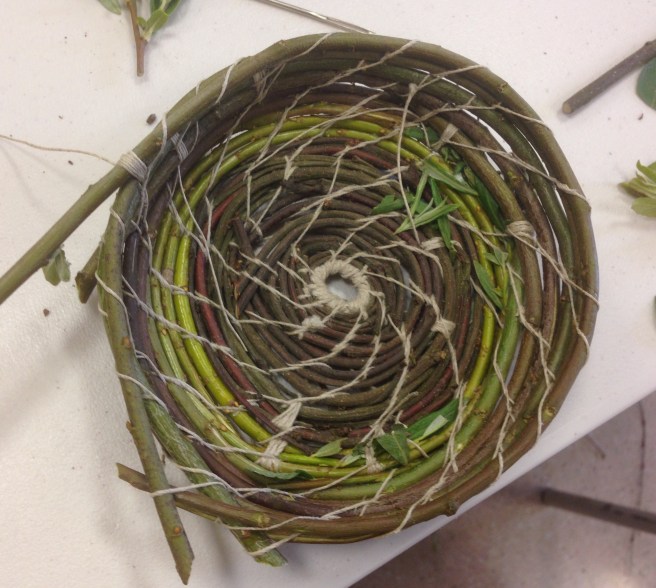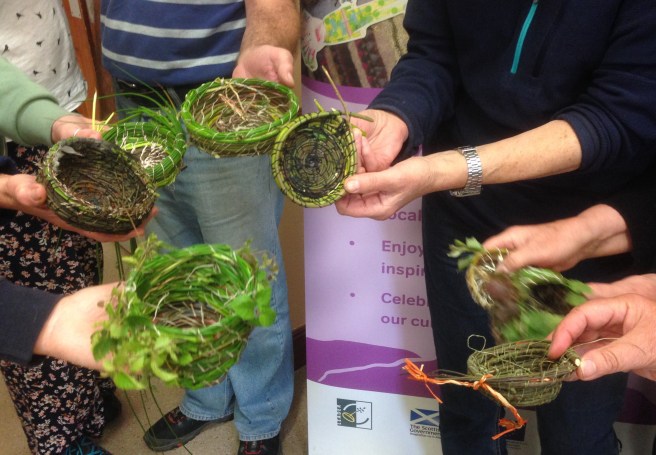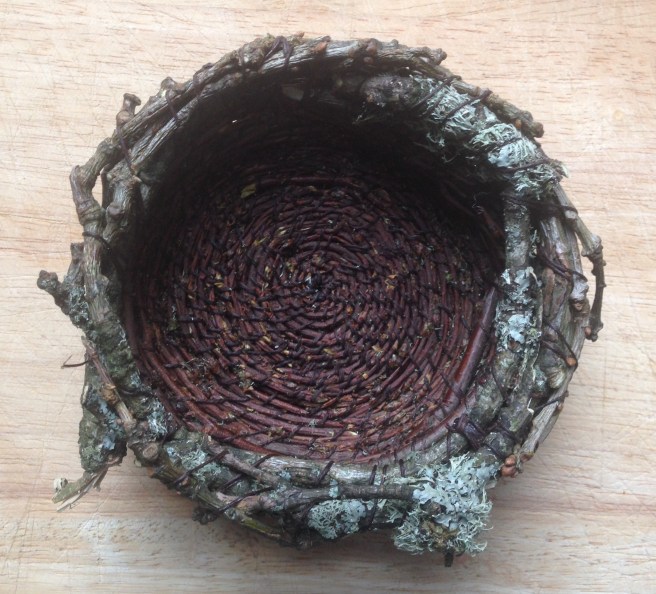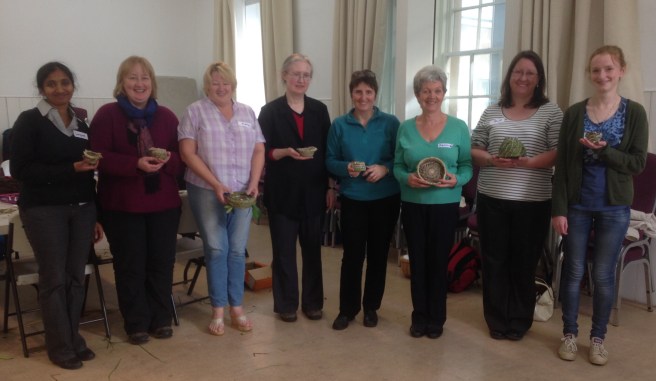
The leaves are coming off the birches and some of the larches (though not the one in this photograph). Time to collect some twiggage for baskets. I’ll be taking some of yesterday’s harvest to Cambo for the Woodworks Taster weekend:
birch
Basket catch-up
Two basket workshops over the last couple of weeks, both very interesting. The first one was for a team from Scottish Natural Heritage at the Centre for Stewardship, Falkland. This was the biggest and fastest basket workshop I’ve ever run! The second was for a smaller group in the fantastic Portmoak Village Hall in Kinross-shire.
The SNH group had meetings and presentations in the morning and a choice of activities for the afternoon. The weather was dreich, the Big Dig on the Estate was rained off so I accepted a group of 20 for ‘Fast Baskets’, a two-hour introductory session of birch coiling and stitching. The atmosphere was relaxed, the concentration was intense, the results were very impressive…
I had prepared and tied bundles of birch twigs to speed up the materials selection process, knowing we would be short of time. I liked the creative use of the raffia binding in this piece.
Lovely use of beachcombed polyprop rope for extra texture and colour.
Alternative function for a tiny basket!
……………………………………………
The Portmoak basket workshop was funded by the Living Lomonds Landscape Partnership for the Portmoak Community Woodland team. They have been doing great work since the mid-1990s on Portmoak Moss, restoring the rare raised bog and surrounding woodland. More info about that on their excellent website: http://www.portmoakcw.org.uk
With permission (of course), I visited the Moss to collect materials to supplement my store of birch twiggage weeded out of the Lochore Meadows Country Park coppice woodland. Portmoak Moss is another undiscovered treasure close to home, I’m very glad this workshop gave me the incentive to explore it. It’s a surreal place. To get onto the Moss you have to climb a well-built flight of steps, taking you up a vertical face of dark dripping peat. At the top you look out over a landscape of grasses, rushes and mosses that could be Highland peat bog – with Bishop Hill in the background to remind you that you’re still in the Lowlands.
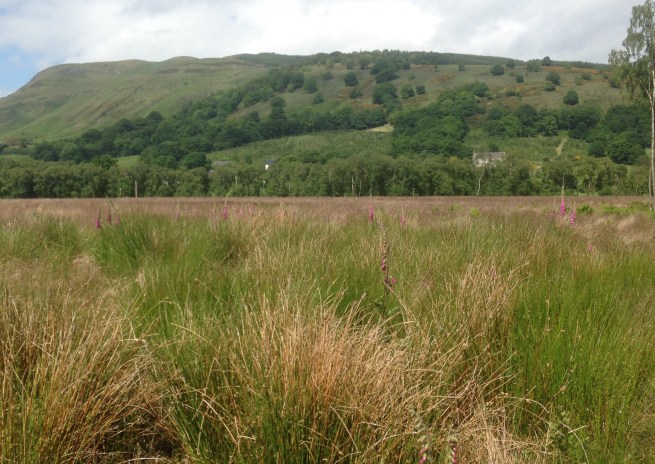
Can you see the deer in this photograph? I was bent over collecting willow twigs when I felt as if I was being watched. I looked up to see a deer looking at me.

It came closer and stopped. I stood still, phone ready to take a photo.
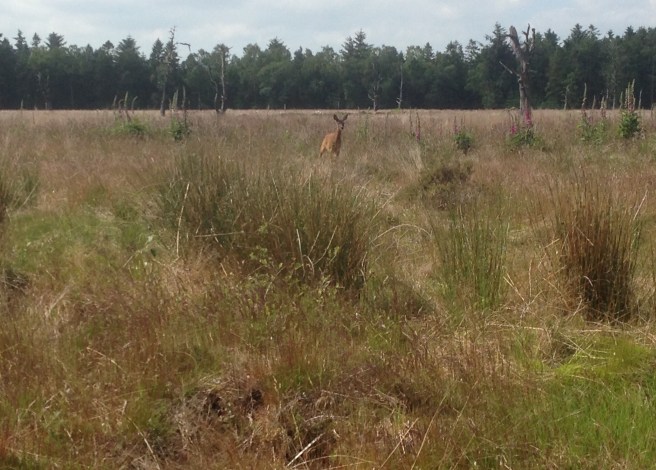
It looked straight at me, sniffed the air and came a bit closer

I don’t know if it identified me at that point but it moved off slowly to the north, grazing as it went

I think it must have caught my scent eventually. It barked and started to run further onto the bog, then stopped again to graze! Very relaxed. Is it used to seeing kind conservationists with well-controlled dogs? Or is it ill? I thought it looked a bit thin, especially around its back-end. Perhaps an elderly roe deer with poor eyesight and failing sense of smell? It ran fast enough though when it decided to go.
Back to the workshop. The materials I collected from the Moss were mostly young trees self-seeded into the peat. Removing these is an on-going battle for the Community Woodland team (hint of irony there), so my plan with the basket workshop was to offer a creative use for the little trees and their roots. It was a bit weird to be pulling up and cutting small native trees, but I looked out over the Moss with its bog cottons and red sphagnums and appreciated the need for tree control. I reassured myself with the thought “all conservation practice is a choice anyway, nowhere is ‘natural’…”
Loch Voil basket
Twiggage
I made a quick visit yesterday to this lovely coppice at Lochore Meadows Country Park:

There’s plenty of evidence of recent work (and picnics?) by volunteers and ranger Dallas Seawright. Each compartment of the coppice woodland is looking great. The hazel is growing well, there are less spruce trees than I remember and the big oaks, birch and other hardwoods look happy in their clear spaces.
I scavenged some twigs from the ground near the fire pit, sat on a mossy log and made a very quick prototype ‘nest’, as an idea for Spring workshops.
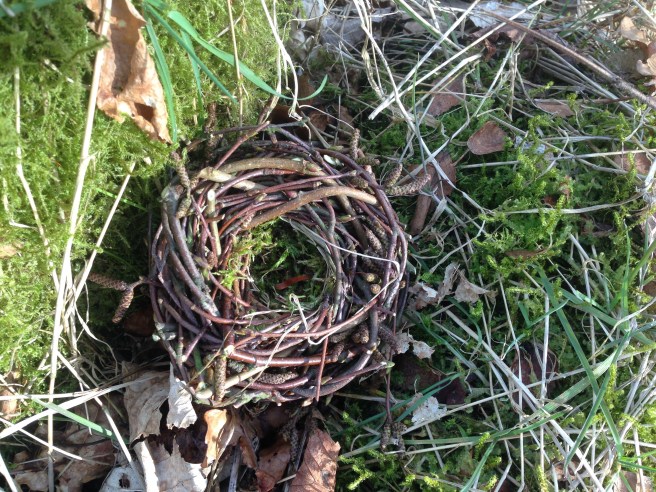
I remember making a nest before and realising very quickly that birds must use a ‘stitching’ technique, holding the materials at the thick end, pushing through, catching, pulling through and winding. There must be video footage out there to watch. I had the advantage of secateurs for trimming stray twigs. With the next nest I’ll take my time and use no tools. I wonder if birds stand back from their work in progress, cock their heads, assess and decide where the next piece should go?
I bumped into the ranger as I was leaving the wood and reassured him that I hadn’t been stealing sticks from the neat piles he’d set aside for pea-sticks and brooms.
Birch and oak
For as long as as I’ve recognised trees as different species, I’ve known there are two kinds of birch tree native to Scotland (not counting the tough little mountain birches). Silver birch is Betula pendula, Downy birch is Betula pubescens. The silver birch prefers drier ground, has jaggier leaves, more beautiful white bark and tends towards an elegant pendulous shape. The clue is in the scientific names as well as the English ones. Downy birch has hairier twigs, a more compact form, rounder leaves and tolerates wind and wet, so is more common in the north and west of Scotland and higher up the hills in the east.
I thought I had this all sorted out in my head years ago but it was brought home to me over the last week while making ‘Birch and oak’. These birch twigs were collected beside the road from Fowlis Wester to Buchanty, up on the moor by Murray’s Hill. It was a bitterly cold day. We walked down the road past the Buchanty Burn, to the fields where we saw black grouse last year. The wildlife was quiet this time, though what we did see was a treat. A stoat in pure white ermine fur-coat was hunting amongst the clearfell stumps near the road. It stopped a few times to watch us watching it, then went about its business, not in the least camouflaged. I’ve a clear memory of a pointed little face with brown fur on its nose, rounded white ears and an intense stare. And a black-tipped tail as it turned 180 degrees round itself and disappeared into the tree roots.
I cut the birch twigs from some saplings growing near a much older sessile oak and collected a few low-hanging oak twigs as well, with the intention of building them all into one basket. I wondered whether the lichen would stay on.
Every basket teaches me something new. This one transformed field-guide knowledge about birches into better understanding of differences between downy and silver. The twigs from Fowlis are matt-effect and soft, compared to the shiny-brown-with-warts twigs I used to make the Loch Tummel baskets in 2014. Those were definitely from silver birch. We untangled the fishing line from some very beautiful pendulous branches…

The Fowlis birch must be downy birch, or maybe a hybrid. I’ll go back for another look in the summer and photograph its leaves. It has a very sweet scent. Combined with beeswax-flower-meadow (on the linen thread) and aromatic-old-oak, the whole basket smells great!
For more info about birch trees:
http://treesforlife.org.uk/forest/birch/
http://treesforlife.org.uk/forest/dwarf-birch/
8 baskets in one day
On Monday this week, eight members of the Forth team from Scottish Natural Heritage joined me at The Steeple for a creative away-day. They swapped keyboards and screens for plants and beeswax, linen thread and needles and each went home with a unique stitched basket.
My heap of basket-making materials was supplemented by armfuls of useful bendy plants, harvested specially by SNH staff at Tentsmuir. I explained how these could be used, demonstrated the first stage of fiddly needle and thread work and the group got started. They picked up the process quickly, and we could see early on that there were going to be eight very different baskets.
I was very impressed with everyone’s willingness to experiment and improvise. By the afternoon there was a fine mess on the tables too, always a good sign. Here are the lovely finished baskets and their makers…
……………………………………………………………………….
Here’s a list of the materials we used, collected with minimum (and some positive) impact on the environment:
Reedmace leaves, marram grass, lyme grass, soft rush, jointed rush, birch twigs, sycamore leaf-stalks, rhododendron twigs and leaves, blackthorn twigs (thorns removed!), beach-combed ships’ ropes, linen thread, bakers’ twine, beeswax.

